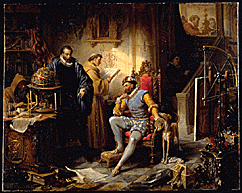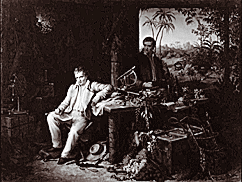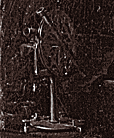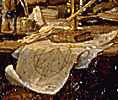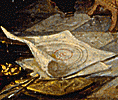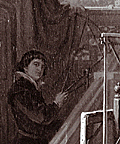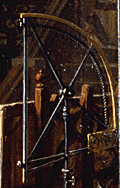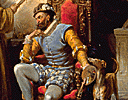
|
Tycho stands before the Emperor with his hand on a clockwork celestial globe, where the coloured constellations are cut out in fretwork. Rudolph is seated and holds a paintbrush and palette, while to the right is a canvas stretched on a frame and resting on an easel. Clearly Tycho is demonstrating or explaining some point of astronomy or, more likely, astrology, while the Emperor listens, or at least half-listens. Astrology is strongly signalled by the manuscript sheet left deliberately hanging over the edge of the desk so as to reveal itself as a diagram of planetary aspects. By contrast, the diagram of planetary motion, probably representing the Tychonic system of the world, lies on the floor at Rudolph's feet. | |
|
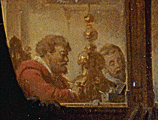
|
Five other men are included in the composition. Behind Tycho are two monks, one seated with an open book but looking at Tycho, the other standing while reading a folio printed volume. To the right of Rudolph is a figure with a hand on an astronomical sextant. Two final figures are seen reading or studying on an upper level reached by a flight of stairs. |
|
Both the sextant and the more prominent quadrant on the right of the picture are known instruments that survive today in the National Technical Museum in Prague. The sextant is confidently attributed to Joost Bürgi, who in 1604 became 'Kammeruhrmacher' or 'clockmaker' to Rudolph. In Ender's time it was thought that Tycho had brought this instrument with him to Prague. The quadrant is unusual in having rackwork on an inner arc engaging cog-wheels that move the indexes of the dials just visible on the right of the instrument. This is an eighteenth-century quadrant and, of course, has no associations with Tycho. |
| Since both these instruments are modelled on extant pieces, and it is clear that the instruments in the Berlin painting are taken from real pieces, it seems almost certain that the clockwork celestial globe also records a real instrument, but this has not been traced. |
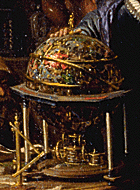
|
It is known that Rudolph had a particularly fabulous mechanical globe by Bürgi, now lost, which displayed the motions of the planets as well as the celestial sphere. Most mechanical spheres of the period indicate the time by the rotation of a complete globe with the clockwork movement inside. If the motions of the planets were to be represented as well, an appropriate and impressive solution would be to accommodate them inside the celestial sphere, to arrange for them to be visible, and to mount the movement outside. The globe in the painting seems to have been formed by applying a series of cut-out and coloured constellations to a set of brass meridian ribs, and has a complex movement beneath. While individual elements depicted in the globe are known from other examples, Ender's painting may be a valuable record of a lost mechanism of an original design; it is difficult to imagine him inventing the piece himself. |

|
Other instruments in the painting are probably too small and commonplace for individual identification, with the possible exception of the equatorial or zodiacal armillary on a stand in the bottom left corner. This is a small version of an observing instrument Tycho had on Hven. Also on the floor are a brass quadrant and a pair of compasses; on the desk with the globe are another pair of compasses, a model of Ptolemy's rulers, a level and a sand-glass; there is a clock among the miscellaneous objects on the shelves behind, while to the right of these a square, a semicircular protractor and a vertical circle hang on the wall. |
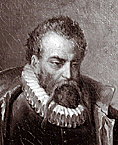
|
Among all this attention to detail, one omission is surprising. Surely the best-known feature of Tycho's appearance was his metal nose, worn to disguise the disfigurement he suffered in a fencing duel. It is now thought that he had one in precious metal - a flesh-coloured blend of gold and silver - for special occasions and another less valuable and less heavy for everyday use.
The Tycho in this picture, however, has a perfect nose and also lacks the scar on his forehead included in other portraits. It is surprising for a painter in this genre to miss so exotic and distinguishing a feature, especially one that evokes other characteristics of the noble astronomer. |
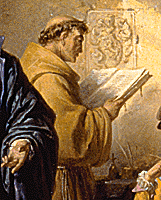
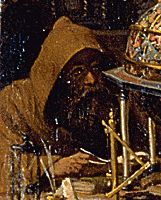
|
The exact occasion Ender may have had in mind in planning his composition remains a mystery. Some allusions in the picture can be guessed at, but that is all. It is known, for example, that Tycho demonstrated a 'mechanism' that Rudolph had noticed among Tycho's effects and that Rudolph remarked that, although he had one or two similar devices, they were smaller and constructed differently. This seems to have been an astronomical mechanism as Rudolph declined Tycho's offer to present it to him, saying that he would have his 'astronomer' make something similar. Tycho had some dealings with monks while he was in Prague, complaining that he was disturbed by their nocturnal devotions, while the monks in their turn did not appreciate the close proximity of a heretic enjoying the patronage of the Holy Roman Emperor. One of the sources available to Ender that deals with Tycho's disagreements with the monks was J. H. Mädler's Populäre Astronomie published in Berlin in 1852. In 1600, when Tycho was asked to live nearby on the Hradschin and was received in audience by the Emperor, Rudolph was disturbed by many anxieties, not least the astrological significance of the dawning of a new century. Some reports implicate Tycho in alarming prognostications around this time, but no specific event has been traced to explain the scene and to identify the other characters in the picture. |

